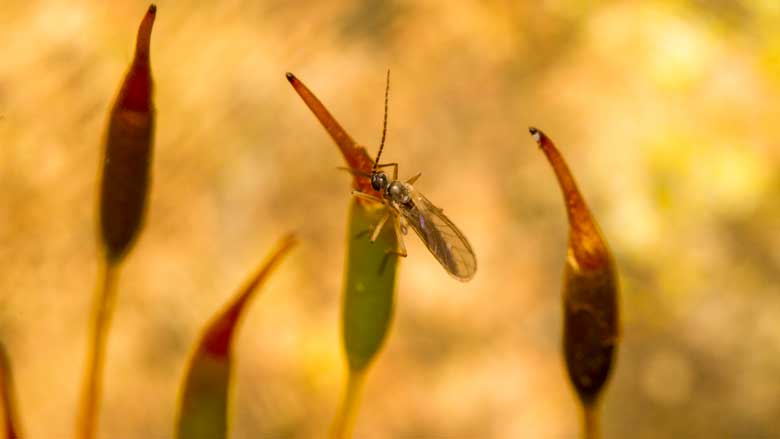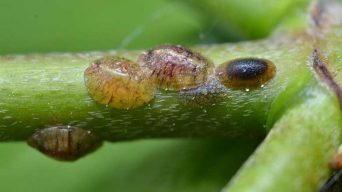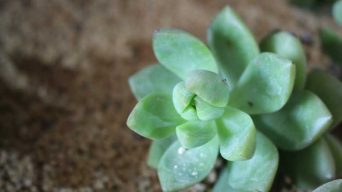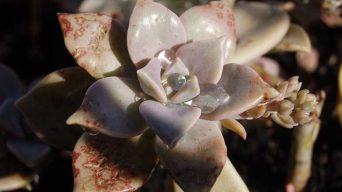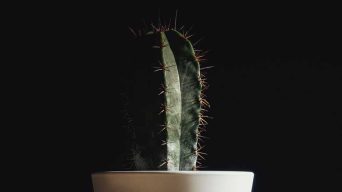Fungus gnats on succulents are small black flies that thrive in moist soil, harming plants by feeding on roots. To eliminate them, reduce soil moisture, use traps, apply insecticidal soap or neem oil, and ensure good drainage. Prevent future infestations by avoiding overwatering and inspecting new plants.
Fungus gnats, those tiny black flies, can wreak havoc on your succulents by feeding on their roots and leaves.
These pests lay their eggs in damp soil and can cause significant damage to your plants if left unchecked.
Whether you’re an indoor gardener or tending to your garden, dealing with fungus gnats is a common issue.
Fortunately, several straightforward methods exist to eradicate these gnats from your succulents and ensure they don’t return.
This article will explore effective strategies for eliminating fungus gnats from your succulents and preventing future infestations.
What Are Fungus Gnats
Fungus gnats are small, black flies that live most of their lives in the soil.
They look similar to fruit flies, and many people think they’re the same, but fungus gnats have more defined wings, which can be seen when looking closer at them.
Fungus gnats are attracted to moisture, so many people find they have a pest infestation after watering their plants.
If you’ve noticed tiny black flies in your home or office, you likely need to eliminate fungus gnats on your succulents.
Appearance and Identification
These gnats will lay their eggs in damp soil rich with organic matter like peat moss or coconut coir.
The fungus gnat larvae look very similar to mosquitoes but without the long proboscis (a tube-like appendage used for feeding), and they have six legs instead of eight.
They like to live in moist soil where they find decomposing plant matter and feed on it, which causes root gnats.
Impact on Succulents
Fungus gnat larvae can cause a lot of damage to your succulents because they will feed on the plant roots, leaves, and stems.
If you’ve noticed some leaves turning yellow or falling off despite regular watering, gnats are probably in your soil.
The gnats can cause root rot, killing your plant, and larvae feeding on the stems or leaves of succulents is just as bad.
Root gnat damage occurs in browning spots along the leaf edges and stem. Gnats can also cause mold to grow, similar to root rot fungus or other pests.
Reasons Succulent Plants Attract Gnats
Succulents attract bugs and gnats for a variety of reasons.
If you have gnats on your succulents, it may be because the plant is not being cared for properly or due to the growing environment.
Gnats that gnaw on your succulent plants are fungus gnats.
The larvae of these little buggers will infest the soil and then lay their eggs there so they can grow up to be gnatty adults.
They do this because it’s an excellent place to feed and breed since fungus thrives in damp soil.
Fungus gnats are attracted to the smell of sugary sap, which succulents exude from their leaves and stems as a nectar-like substance for ants that helps protect them against other insects.
The gnats love these sweet secretions so much that they’ll lay eggs on your plants if there are enough tasty treats.
The gnats after your succulents might be attracted to the smell of their sweet nectar, but they’re also drawn in by bright lights at night, so you need to turn off any nearby lighting if you want them gone for good.
Gnats can live outdoors, too, so you might need to deal with gnat infestations in your succulent garden if gnats are breeding there.
Causes of Fungus Gnat Infestations in Succulents
Succulents are gnat magnets for several reasons.
Fungus gnats love damp soil, so they’ll lay their eggs in the potting mix if it stays wet for a long time without drying out.
This situation may arise when you excessively water your succulents, causing the soil to remain overly damp for an extended period. Succulents will rot in this environment, and gnats love rotten plant matter since it provides ample breeding grounds.
Also, gnats can come in on succulents from outdoors. If the soil of your plants didn’t dry enough after you transplanted them, gnat eggs may have been brought into the pot with the plant and started hatching once they were planted.
A third reason gnats might be attracted to your succulents is that gnats love the sticky sap that succulents produce.
If gnats have been flying around your plants and getting stuck in this sap, they may decide to lay their eggs there before taking off again.
When you see gnat adults flitting about your soil, it’s time for action!
Signs of Fungus Gnat Presence
Fungus gnats are small gnat-like insects that are easily identified by the presence of their wings.
They have long legs and a larger abdomen than other gnats, allowing them to fly long distances if needed.
Gnats tend to be black or brown but can also come in a lighter tan shade.
Gnats love moisture and humidity at all times of the year, particularly wintertime when it is cold outside, and they cannot find water anywhere else!
Succulent plants seem like perfect hosts for gnats because succulents naturally trap water inside themselves, so you don’t need watering very frequently – thus creating the ideal breeding ground for these pests.
You can know that you’re dealing with a fungus gnat infestation if the leaves of your succulent plants become yellow and distorted.
If so, they may have been gnawed on by these tiny insects – though this doesn’t necessarily mean gnats are present.
Before knowing what type of pest is attacking your succulents, you must look for other signs, such as larvae or adults.
The Life Cycle of Fungus Gnats: Spotting Adults, Larvae, and Eggs
The gnat life cycle is short – it takes about two weeks for an adult to reach adulthood.
The female gnats will lay between 20 and 40 eggs at a time on the soil of your succulent pot or in crevices where moisture can gather.
These sometimes fall off into other areas, so be sure you check every inch of your home if you see these succulent pests outside!
The larvae hatch from their egg casings after just one day and then eat away at any available plant material around them until they pupate into adults that fly away once again.
Adult gnats live only long enough to mate before dying, but it takes longer than two weeks for them to become adults.
After the gnats lay their eggs, it takes about a month for the larvae to hatch and eat away at your succulents. Then they pupate into gnat adults that live just two weeks before laying more eggs!
Effective Methods for Eradicating Fungus Gnats
Fungus gnats can be a vexing issue for succulent enthusiasts. Dealing with these tiny pests can be a nuisance, especially when they hover around your plants and disrupt your evenings.
Swift action is crucial once you notice their presence in your cherished succulent collection.
First, it’s essential to accurately identify whether you’re dealing with gnats or fruit flies, as the methods for eliminating them differ.
Distinguishing between the two is relatively straightforward. Fruit flies typically have clear and black wings, while fungus gnats possess more opaque wings with a brownish-grey tint.
Next, it helps to know what triggers them to get out of their tiny gnat-sized homes (usually your succulent soil). Here are some things that can trigger gnats flying around:
- If there’s too much moisture in the air (this means humidity)
- If there isn’t enough ventilation for your plants
- If you’re overwatering your poor plant! This might seem obvious, but we all get busy sometimes and forget our responsibility to care for our succulents.
Now that you know what to look out for, it’s time to get gnat-killing! Here are some gnat-killing methods you can use:
1. Utilizing Gnat Traps
One of the most effective ways is to buy gnat traps, essentially sticky tape that gnats get stuck on.
The only drawback with these suckers is that they don’t discriminate between types of gnats, so if you have both fruit flies and gnats, it will kill them all!
2. Applying Alcohol Spray
Take a bottle of rubbing alcohol (the highest concentration level) and spray your plants wherever there’s moist soil or water deposits.
You should see results within 24 hours, as the gnats will suffocate in this environment.
If you’re worried about killing off any beneficial bacteria in your succulent pots, as I do, make sure not to overdo it with the alcohol.
One or two spritzes should do it!
3. Using Diatomaceous Earth
This gnat-killing powder is made up of crushed sedimentary rock rich in silica. It will dry out the gnats and leave them dead.
You can either sprinkle DE on your succulent soil or take a fine brush to get between all those tiny spaces where gnats like to hide.
I use this method sometimes if my plants are infested because it’s gentle enough that you don’t have to worry about killing any gnat eggs that might be lurking!
4. Treating with Hydrogen Peroxide
If gnats are already flying around your plants like crazy, you can put a few drops of hydrogen peroxide in the soil to kill off any gnat eggs that might be there.
This method is not as effective for gnats already flying around and will work better if combined with other methods on this list.
5. Employing Cinnamon Powder
Cinnamon powder is a gnat’s worst enemy. The stuff will kill them on contact and has a pleasant smell!
The thing to remember with this gnat-killing method is that it works best if you’re proactively sprinkling the cinnamon powder wherever there’s moist soil or gnats are being seen.
If you use too much at once, your plants might have difficulty absorbing water until the gnat killer wears off, so be careful!
6. Implementing Neem Oil
Neem oil is known to kill off gnats, and it also has a nice side-effect of repelling other gnat species from settling in your succulent soil!
This stuff will eliminate gnats while leaving the beneficial bacteria intact, so you should still be able to use this method even if you have root rot or fungus gnats.
7. Applying Dish Soap Solution
This gnat-killing method is simple: take some dish soap (the cheaper, the better) and mix it with water.
Don’t worry about diluting too much because gnats can handle a bit of harshness! Just spray this mixture wherever moist soil or gnats are being seen.
Strategies for Preventing Future Infestations
Fungus gnats are a common problem for succulent owners. They can be extremely annoying, but fortunately, they’re easy to prevent!
1. Watering Techniques and Soil Drainage Improvement
The gnats thrive in moist soil, so ensuring your succulents are never too wet is the most important thing.
We recommend using a soil with excellent drainage and ensuring that water does not accumulate on top of the soil after watering your plant!
You may also want to avoid water from above or mist succulents since gnats are attracted to the water droplets on leaves after you’ve watered your plants.
Don’t overwater your succulents with a poorly draining soil mix. Water sparingly, allowing the top of the soil mixture to dry out before watering again.
2. Regular Repotting with Fresh Soil
It’s also helpful to replace old or bad/moldy soil from time to time by repotting it into fresh, new, organic quality soil.
This way, you can prevent gnat infestations by removing potential breeding grounds from gnats developing inside old pots that were too wet for long periods.
When repotting succulents, always use fresh potting soil that has perlite or sand added to it.
3. Keeping the Plant Area Debris-Free
It is also essential to remove all debris around your plant—gnats like to lay their eggs in dead plant matter. You will want to ensure that all of the gnats’ breeding grounds are removed.
Remove any dead leaves, flowers, or stems from your succulent regularly, and keep your plant free of debris around it.
Don’t let gnats breed anywhere around your succulent by regularly removing debris and dead matter.
4. Positioning Succulents Away from Damp Areas
Keeping your succulent plant out of regularly wet areas can also prevent gnats from breeding in these areas.
You may want to avoid growing succulents near places where you use water, such as the sink or shower.
If gnats are a problem in your house, you may want to avoid keeping them near drains or any other wet area.
Keep your succulents out of areas with high moisture and humidity that gnat larvae like to breed in.
If gnats are a persistent problem for you, then placing your succulents in a location with lower humidity can be helpful.
Isolating Infested Plants Promptly
To effectively manage a gnat infestation, it’s crucial to immediately isolate infested plants, especially succulents, from your collection.
Gnats, capable of flying and spreading rapidly, can exacerbate the problem if not addressed swiftly.
By promptly removing any succulent affected by gnats, you can prevent their spread throughout your home and protect your other plants.
Final Thoughts
Fungus gnats are a common issue with succulents, but they can be easily managed with the right knowledge.
Quick action is vital when gnats appear; eliminating them promptly prevents damage and stops their reproduction.
Gnats thrive in moist environments, so drying out the soil and removing standing water is key.
Additionally, removing their food sources is essential for long-term prevention.
Remember, prevention is more effective than treatment. Always inspect new succulents for gnats or larvae before bringing them indoors to avoid future problems.

